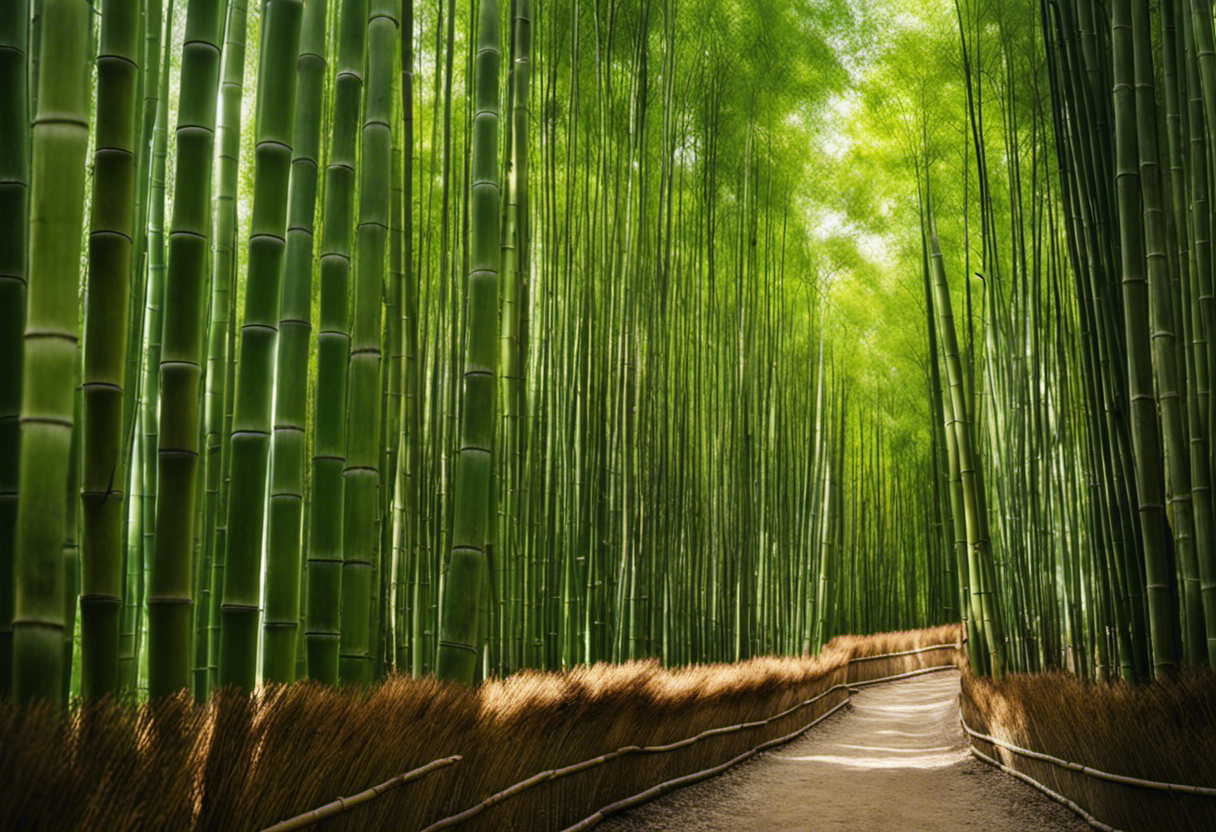Bamboo, a versatile plant known for its strength and rapid growth, has captured the interest of many gardeners and landscapers. However, achieving optimal growth conditions is crucial for successful cultivation.
Did you know that bamboo can grow up to 35 inches in a single day? This article explores the scientific and technical aspects of creating the ideal environment for bamboo growth, including:
- Soil quality
- Sunlight exposure
- Water requirements
- Temperature range
- Wind conditions
- Fertilization and nutrient needs.
Key Takeaways
- Well-drained soil with good fertility is essential for successful bamboo growth.
- Most bamboo species thrive in full sun conditions, but some can tolerate partial shade.
- Adequate water supply is crucial, but overwatering should be avoided to prevent root rot.
- Implementing windbreaks and selecting wind-resistant bamboo varieties can protect bamboo from damage caused by excessive wind.
Soil Quality

The soil quality plays a crucial role in ensuring the successful growth of bamboo. Bamboo requires a well-drained soil with good fertility and a slightly acidic to neutral pH level. Incorporating organic matter into the soil through composting can greatly benefit its growth. Composting is a process that involves the decomposition of organic materials such as kitchen scraps, yard waste, and manure. This practice enriches the soil with essential nutrients, improves its structure, and enhances water retention capacity.
Organic gardening techniques, such as crop rotation and cover cropping, can also contribute to soil health and fertility. These methods reduce the reliance on synthetic fertilizers and pesticides, creating a more sustainable and environmentally friendly approach to bamboo cultivation. By prioritizing soil quality and adopting organic gardening techniques, growers can optimize bamboo growth and promote a healthy ecosystem.
Sunlight Exposure



To promote healthy bamboo growth, ensuring proper sunlight exposure is essential. Bamboo plants have specific shade preferences and require varying degrees of sunlight exposure depending on the species and seasonal variations.
Most bamboo species thrive in full sun conditions, receiving at least 6 to 8 hours of direct sunlight per day. However, some varieties, such as the clumping bamboo, can tolerate partial shade and still grow well. It is important to consider the specific shade requirements of each bamboo species when planning their placement in your garden.
Additionally, seasonal variations play a role in sunlight exposure. During the winter months, when the sun is lower in the sky, bamboo plants may receive less direct sunlight. Therefore, it is advisable to monitor and adjust the placement of bamboo plants accordingly to ensure they receive optimal sunlight exposure throughout the year.
Water Requirements



Proper irrigation is crucial for ensuring optimal growth of bamboo plants. Bamboo requires an adequate supply of water to thrive, but excessive or insufficient amounts can hinder its growth. The water requirements of bamboo vary depending on factors such as climate, soil conditions, and the specific species.
Irrigation techniques play a significant role in meeting these requirements. Drip irrigation is commonly used for bamboo cultivation as it provides a controlled and efficient water supply directly to the roots, minimizing water loss through evaporation. Additionally, bamboo exhibits a remarkable drought tolerance once established. Its extensive root system enables it to access water stored deep within the soil, allowing it to survive in dry conditions.
However, during the initial growth phase, regular watering is necessary to facilitate root development and ensure successful establishment.
Temperature Range



For successful bamboo growth, it is crucial to consider the optimal temperature range. Different bamboo varieties have varying temperature preferences, but most prefer a temperature range between 18°C to 35°C (64°F to 95°F) for optimal growth.
Temperatures below 10°C (50°F) or above 40°C (104°F) can negatively impact bamboo growth and development. Cold temperatures can slow down the growth rate and cause damage to the plant, while extremely hot temperatures can lead to dehydration and stress.
It is important to note that some bamboo varieties are more cold-tolerant, while others are more heat-tolerant. Identifying the temperature range suitable for specific bamboo varieties is essential for ensuring their healthy growth and maximizing their growth rate.
Wind Conditions



When considering the growth of bamboo, wind conditions play a crucial role in determining its success.
The ideal wind speed for optimal growth ranges between 5 to 15 miles per hour, as excessive wind can cause damage to young bamboo shoots.
Moreover, the direction of the wind also impacts the growth pattern of bamboo, as it can influence the bending and leaning of the stems.
To protect bamboo from strong winds, strategies such as windbreaks and planting in sheltered areas can be implemented to create a conducive environment for its growth.
Ideal Wind Speed
The optimal wind speed for successful bamboo growth is determined by various factors. Factors affecting wind speed include the geographical location, topography, and surrounding vegetation.
Bamboo thrives in areas with moderate wind speeds, as excessive wind can cause physical damage to the plants, leading to stunted growth or even death. On the other hand, insufficient wind can hinder proper pollination, which is crucial for the bamboo’s reproductive cycle.
Wind plays a vital role in pollination by carrying pollen from the male flowers to the female flowers, facilitating fertilization. Therefore, a balance must be maintained to ensure the ideal wind speed for bamboo growth.
Wind Direction Impact
Wind direction has a significant impact on the wind conditions necessary for successful bamboo growth. Understanding the wind patterns and their effects is crucial for creating optimal conditions for bamboo cultivation. The direction from which the wind blows determines the airflow around the bamboo plants, affecting their growth and overall health.
When wind blows parallel to the bamboo rows, it creates laminar airflow, allowing for efficient exchange of gases and promoting transpiration. This helps the plant to regulate its temperature and prevents the build-up of excessive moisture, reducing the risk of fungal diseases. Additionally, laminar airflow assists in the pollination process by facilitating the dispersion of pollen.
On the other hand, if the wind direction is perpendicular to the bamboo rows, it can cause turbulent airflow. This turbulent airflow disrupts the exchange of gases, inhibits transpiration, and hinders pollination. It also increases the risk of physical damage to the bamboo stalks due to bending or breaking.
To optimize wind conditions for bamboo growth, it is essential to consider the prevailing wind patterns in the specific region and align the bamboo rows accordingly. By doing so, it is possible to establish an environment that encourages healthy bamboo growth and maximizes productivity.
Wind Protection Strategies
To ensure optimal wind conditions for bamboo growth, implementing effective strategies for wind protection is essential. Bamboo propagation can be negatively affected by strong winds, which can cause damage to the plants and hinder their growth.
There are several strategies that can be employed to protect bamboo from wind, such as planting windbreaks or creating sheltered areas using structures like fences or walls. Windbreaks, consisting of trees or shrubs, can help block or redirect strong winds, reducing their impact on the bamboo plants.
Additionally, selecting suitable bamboo varieties that are more resistant to wind can contribute to successful growth in windy conditions.
It is important to consider wind protection strategies when planning and maintaining bamboo plantations to ensure optimal growth and productivity.
Fertilization and Nutrient Needs



Bamboo growth requires appropriate fertilization and nutrient management to ensure healthy and vigorous plant development. To meet the nutrient needs of bamboo, compost application and organic fertilizers are highly recommended.
Compost is an excellent source of organic matter and essential nutrients that can improve soil fertility and promote the growth of bamboo. Organic fertilizers, such as manure or bone meal, provide slow-release nutrients that are readily available to the bamboo plant. These fertilizers also help improve soil structure, moisture retention, and microbial activity.
When applying compost and organic fertilizers, it is important to consider the specific nutrient requirements of the bamboo species and the soil conditions. Regular soil testing can help determine the appropriate application rates and timing for fertilization, ensuring optimal nutrient uptake by the bamboo plants.
Conclusion
In conclusion, the optimal conditions for successful bamboo growth require careful consideration of various factors.
The soil quality must be suitable, providing adequate nutrients and drainage.
Sunlight exposure should be sufficient to promote photosynthesis and growth.
Water requirements must be met, ensuring proper hydration without waterlogging.
The temperature range should be within the species’ tolerance, protecting against frost or extreme heat.
Wind conditions should be moderate to prevent damage to the plants.
Lastly, fertilization and nutrient needs must be met to support healthy growth.
Symbolically, these conditions represent the delicate balance necessary for prosperity and resilience in life.

